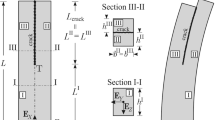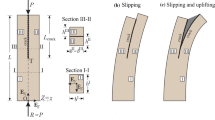Abstract
Engineering structures are having structural defects such as cracks due to long-term services, vibrations and material non-uniformity. Cracks in structural members cause to local changes in their stiffness, and consequently, their static and dynamic behaviour is changed. Analytical and numerical have been developed during the years. In this present work, the buckling of column with single and multiple non-propagating edge cracks is studied by use of the finite element method (ANSYS12) and transfer matrix method. The column is modelled as an assembly of sub-segments connected by mass less rotational springs whose flexibilities depend on the local flexibilities introduced by the cracks. Further, results are compared by ANSYS12 and transfer matrix method.
Access provided by Autonomous University of Puebla. Download conference paper PDF
Similar content being viewed by others
Keywords
1 Introduction
As the jib crane is used for material handling purpose in most of the manufacturing industries. Jib crane having a hanging arm which acts as a cantilever beam thus it is subjected to axial compressive load and moment; also, it is subjected to the vibrations caused by various heavy machinery it is entrapped by cracks which further turn into failure. The cracks may develop from the long-term service, impact applied cyclic loads, aerodynamic loads, shrinkage, etc. Therefore, it is very essential to analysis the behaviour of buckling, stability of column, vibration analysis, crack failure [1,2,3,4,5]. A jib crane comprises of a derrick bolstered on a level bar that is cantilever from a vertical section, the flat bar turns about the vertical hub framed by the segment to give an even range to the crane [4]. The beam also serves as the track for the hoist trolley to provide radial travel along the length of the beam (Fig. 1). Standard capacities of a jib crane range up to about 5000 kg and can rotate 180–360°. The mechanical properties of structural steel are mentioned in Table 1.
2 Modelling Software
CATIA is used to create model of column [6,7,8]. Solid model of column is shown in Fig. 2.
2.1 Analysis Software
The ANSYS 12.0 is used for structural analysis of column [9,10,11]. Material data selected for pre-process is structural steel. Input parameters for ANSYS are given in Table 2.
2.2 Beam Element
SOLID45 is utilized for the 3D displaying of strong structures [12, 13]. The component is characterized by eight hubs having three degrees of opportunity at every hub: interpretations in the nodal x, y and z headings as shown in Fig. 3. The element has plasticity, creep, swelling, stress stiffening and large deflection. The degrees of freedoms for solid45 beam element are UX, UY and UZ.
2.3 Mesh Model and Boundary Conditions
Mapped mesh model generated using tetrahedron 4 nodes as shown in Fig. 4. Total number of nodes are 8138, and total number of elements are 4278.
Boundary conditions taken as shown in Fig. 5 with ‘A’—Zero displacement provided in ‘X’ Direction ‘B’—Zero displacement provided in ‘Y’ Direction ‘C’—Zero displacement provided in ‘Z’ Direction ‘D’—Force applied of 1764 N. Static structural analysis of column without crack is shown in Fig. 6.
3 Static Structural Analysis of Column with Single Crack
Consider crack in column of jib crane as depth 13 mm, width 6.5 mm, thickness 2 mm, position 212 mm (from top) as shown in Fig. 7. The analysis results for column with single crack are shown in Figs. 8, 9 and 10.
Load multiplier for single cracked column is given in Table 3. Load multiplier factor is computed 658.68, and thus, the critical load for buckling is calculated as:
Critical load = Load multiplier × Force applied.
Critical load = 684.37 × 1764.
Critical load for a single crack column = 1207.22 k.
3.1 Static Structural Analysis of Column with Multiple Crack
Consider multiple cracks in column (Fig. 11) with their locations as depth 13 mm, width 6.5 mm, thickness 2 mm, position 1st crack 212 mm (from top end), position 2nd crack 227 mm (from top end), position 3rd crack 257 mm (from top end). Analysis results for column with multiple crack are shown in Figs. 12 and 13.
4 Buckling Load Calculation for Multiple Cracks
Load multiplier factor is calculated as 676.04 as shown in Table 4, and thus, the critical load can be calculated as:
Critical load = Load multiplier × Force applied.
Critical load = 676.04 × 1764.
Critical load for a multi-cracked column = 1192 kN.
4.1 Transfer Matrix Method
In the numerical model, the split areas are commonly spoken to as massless rotational springs. Additionally, local adaptability coefficients of these springs are elements of the profundities of splits and the distance across of the cross-segment of the segment (Fig. 14).
The differential equation for buckling of the first segment can be written as:
Solution of above differential equation is: y1(x) = A1 + A2 x + A3sin(kx) + A4cos(kx).
Where k2 = P/EI, and P is the axial compressive force.
The generalized solution for above equation is given by:
where [T1] is called ‘the transfer matrix’.
and
After applying boundary condition (one end fixed and other end is free) in above equation will reduce to:
5 Results and Discussion
5.1 Buckling Load for Single Column Using Transfer Matrix Method
The generalized equation for single crack column:
where β = xCi/L, and Ci is flexibility of cracked column.
For jib crane column.
L = 360 mm.
D = 50 mm.
β = 0.58.
Ci = 0.26.
k = 0.00170.
Thus after substitution of values of L, β, Ci and k in above equations, critical buckling load for single cracked jib crane column (Pcr) is calculated as 1740 kN.
5.2 Buckling Load for Multiple Column Using Transfer Matrix Method
The generalized equation for multiple cracks is:
For jib crane column with multiple cracks.
L = 360 mm, i = 1 … 3.
D = 50 mm.
β1 = 0.58,
β2 = 0.63,
β3 = 0.71,
Ci = 0. 26,
k = 0.0001497.
k2 = P/EI.
Thus after substitution of values of L, β1, β2, β3, C and k in above equation, critical buckling load for single cracked jib crane column (Pcr) is calculated as 1345.81 kN.
Thus, the buckling load values obtained by ANSYS and transfer method are compared and provided in Table 5.
6 Conclusion
It considered that a changing position of cracks causes more reduction in critical buckling load than in case of multiple cracks. It shows the variation of the critical load to the buckling load depending upon the dimension crack depth a/D for the dimension crack location of x/L. If the location of the crack changes nearer to fixed end where the buckling moment is maximum results in a greater reduction in the critical buckling load and is therefore more critical in the stability behaviour of the column.
From transfer matrix method, the critical buckling load of multiple cracked column is 22% lower in comparison with single cracked column. From ANSYS12, the critical buckling load of multiple cracked column is 13% lower in comparison with single cracked column.
References
Chandra Kishen JM, Kumar A (2004) Finite element analysis for fracture behaviour of cracked beam columns. Finite Elem Anal Des 40:1773–1789
Gurel MA (2007) Buckling of slender prismatic circular columns weakened by multiple edge cracks. Acta Mech 188:1–19
Chan SL, Su GP (2002) Stability analysis and parametric study of pre-stressed stayed columns. Eng Struct 24:115–124
Springer WT, Rezniek A The prediction of the natural frequencies shifts for a cantilever L-section beam due to the presence of a crack. In: 12th international modal analysis conference, vol 994. pp 889–897
Stubbs N (1990) Global non-destructive damage evaluation in solids. Int Modal Anal Conf 5:67–79
Sharma SK, Sharma RC (2018) Simulation of quarter-car model with magnetorheological dampers for ride quality improvement. Int J Veh Struct Syst 10(3):169–173
Sharma SK, Chaturvedi S (2016) Jerk analysis in rail vehicle dynamics. Perspect Sci 8:648–650
Sharma SK, Kumar A (2018) Multibody analysis of longitudinal train dynamics on the passenger ride performance due to brake application. In: Proceedings of the institution of mechanical engineers part K: journal of multi-body dynamics
Pinabasi S, Okay F, Akpinar E, Erdogan H Stability analysis of two segment stepped columns with different end conditions and internal axial loads. Math Prob Eng 2013. Article Id: 858906
Sharma RC, Palli S, Koona R (2017) Stress and vibrational analysis of an Indian railway RCF bogie. Int J Veh Struct Syst 9(5):296–302
Palli S, Koona R, Sharma SK, Sharma RC (2018) A review on dynamic analysis of rail vehicle coach. Int J Veh Struct Syst 10(3):204–211
Sharma RC, Sharma SK (2018) Sensitivity analysis of three-wheel vehicle’s suspension parameters influencing ride behavior. Noise Vib Worldwide 49(7–8):272–280
Sharma SK, Saini U, Kumar A (2019) Semi-active control to reduce lateral vibration of passenger rail vehicle by using disturbance rejection and continuous state damper controller. J Vib Eng Technol 7(2)
Author information
Authors and Affiliations
Corresponding author
Editor information
Editors and Affiliations
Rights and permissions
Copyright information
© 2021 The Author(s), under exclusive license to Springer Nature Singapore Pte Ltd.
About this paper
Cite this paper
Vishwakarma, P.N., Sharma, A. (2021). Structural Analysis of Single and Multiple Cracked Column with Buckling Using Fem. In: Joshi, P., Gupta, S.S., Shukla, A.K., Gautam, S.S. (eds) Advances in Engineering Design. Lecture Notes in Mechanical Engineering. Springer, Singapore. https://doi.org/10.1007/978-981-33-4684-0_10
Download citation
DOI: https://doi.org/10.1007/978-981-33-4684-0_10
Published:
Publisher Name: Springer, Singapore
Print ISBN: 978-981-33-4683-3
Online ISBN: 978-981-33-4684-0
eBook Packages: EngineeringEngineering (R0)


















